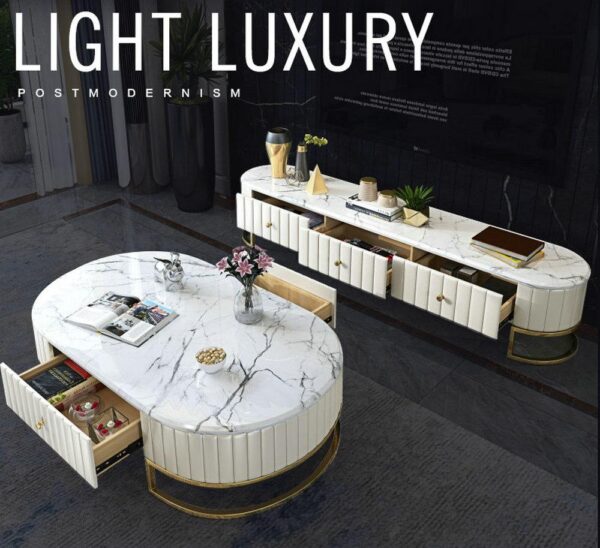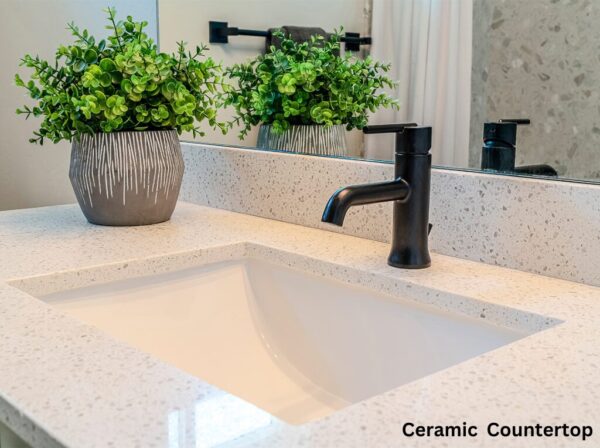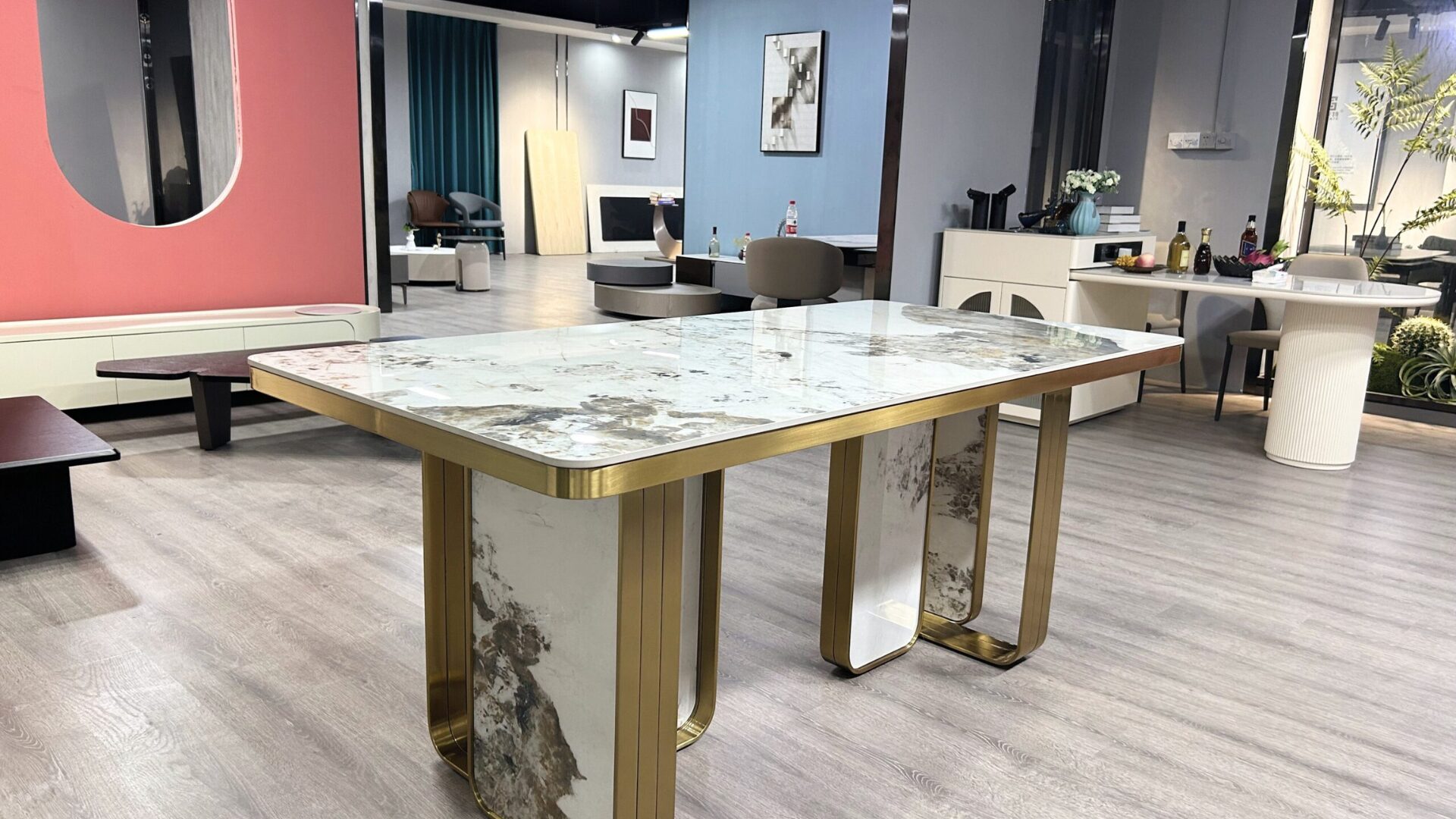Why Choose Sintered Stone Top Furniture Over Other Stones?
Have you ever wondered why sintered stone is gaining popularity as a preferred choice for countertop material? In the world of interior design and architecture, sintered stone has emerged as a revolutionary material, offering a blend of aesthetics, durability, and sustainability.
Sintered stone is a synthetic material created by compacting and sintering mineral raw materials such as quartz, silica, and minerals at very high temperatures. The result is a dense, non-porous surface that is highly resistant to scratches, stains, and heat.
Its composition makes sintered stone an ideal choice for various applications, especially as a countertop material. In this blog post, we will explore the characteristics of sintered stone, its benefits over other traditional materials like marble, quartz, and ceramic, its design options, and ultimately, why choosing sintered stone may be the best decision for your next project.
What is a Sintered Stone?
Sintered stone is a cutting-edge material that combines the beauty of natural stone with the durability of engineered surfaces. It is made by compacting and fusing minerals under intense heat and pressure, mimicking the natural process of stone formation. The result is a solid surface that is extremely strong, resistant to heat, scratches, and stains, and has a uniform appearance throughout its thickness.

Unlike natural stone, which is quarried and cut into slabs, sintered stone is manufactured in large slabs, allowing for greater design flexibility and larger seamless surfaces. It comes in a wide range of colors, patterns, and finishes, making it suitable for a variety of applications, from kitchen countertops to wall cladding. Additionally, sintered stone is also an eco-friendly choice, as it is made from natural minerals and does not emit any harmful substances. Its durability and low maintenance requirements make it a practical and long-lasting option for both residential and commercial projects.
Benefits of Sintered Stone as a Countertop Material
Sintered stone offers a multitude of benefits that make it a superior choice for countertops. Its durability, resistance to stains and heat, and low maintenance requirements make it an excellent investment for any home or commercial space.
Durability
Sintered stone is incredibly durable, making it resistant to scratches, stains, and heat. This durability ensures that your countertops will remain in excellent condition for years to come, even with regular use.
Non-Porous Surface
The non-porous nature of sintered stone makes it highly resistant to stains and bacterial growth. This makes it an ideal choice for kitchens and bathrooms where hygiene is a top priority.
Low Maintenance
Sintered stone requires minimal maintenance, only needing to be wiped down with a damp cloth and mild detergent. This makes it easy to clean and maintain, saving you time and effort.
Design Versatility
Sintered stone comes in a wide range of colors, patterns, and finishes, allowing for endless design possibilities. Whether you prefer a modern, sleek look or a more traditional style, sintered stone can complement any aesthetic.
Sintered Stone vs. Marble
When it comes to choosing a material for your countertops, both sintered stone and marble offer unique benefits and drawbacks. Understanding the differences between the two can help you make an informed decision based on your specific needs and preferences.
Appearance: Marble is prized for its natural beauty and unique veining patterns, which can vary greatly from slab to slab. Sintered stone, on the other hand, is engineered to replicate the look of natural stone, offering a more uniform appearance.

Durability: Sintered stone is more durable than marble, as it is resistant to scratches, stains, and heat. Marble, being a softer and more porous stone, is more prone to scratching and staining, and can be damaged by high heat.
Maintenance: Marble requires more maintenance than sintered stone, as it needs to be sealed regularly to protect against stains and etching. Sintered stone, being non-porous, is easier to clean and maintain.
Cost: Marble stone top is generally more expensive than sintered stone, both in terms of the material itself and the installation costs. Sintered stone offers a more affordable alternative that still provides the look of natural stone.
Environmental Impact: Sintered stone is considered more environmentally friendly than marble, as it is made from natural minerals and does not require quarrying of large stone blocks.
Ultimately, the choice between sintered stone and marble will depend on your budget, aesthetic preferences, and lifestyle factors.
Also Read: Is Sintered Stone Better Than Marble?
Sintered Stone vs. Quartz
When deciding between sintered stone and quartz for your countertops, it’s important to consider their differences in terms of durability, maintenance, appearance, and cost.
Durability: Sintered stone is slightly more resistant to heat and scratches compared to quartz, although both materials are highly durable. Quartz, however, is more flexible, making it less prone to chipping.
Maintenance: Both sintered stone and quartz require only regular cleaning with mild soap and water, making them low maintenance materials. Quartz, however, is more susceptible to damage from harsh chemicals compared to sintered stone.
Appearance: Sintered stone offers a wide range of colors and patterns, as it is engineered to mimic the look of natural stone. In contrast, quartz is more uniform in appearance, as it is manufactured using a combination of quartz crystals and resin.

Cost: In terms of cost, quartz is generally more affordable than sintered stone. The price of sintered stone can vary depending on the brand and quality, but it is typically more expensive than quartz.
Environmental Impact: Both sintered stone and quartz are considered environmentally friendly options, as they are made from natural minerals and are non-porous, making them resistant to bacteria growth.
Sintered Stone vs. Ceramic
When comparing sintered stone and ceramic for countertop surfaces, several factors come into play, including durability, aesthetics, maintenance, and cost.
Durability: Sintered stone lasts longer than ceramic because it’s harder to chip, scratch, or damage with heat. Ceramic, while tough, can be more easily chipped, scratched, or damaged by heat.
Aesthetics: Sintered stone comes in many colors, patterns, and finishes, giving you more options than ceramic. Sintered stone can look like natural stone, while ceramic usually looks the same all over.

Maintenance: Both sintered stone and ceramic are easy to take care of, needing only regular cleaning with mild soap and water. But ceramic might stain or chip more easily over time compared to sintered stone.
Cost: Ceramic is generally cheaper than sintered stone because it costs less to make. Sintered stone can be more expensive because of how it’s made and how durable it is.
Environmental Impact: Both sintered stone and ceramic are good for the environment. They’re made from natural materials and can be recycled.
Sintered Stone Design Options
When it comes to designing with sintered stone, the options are virtually endless. From replicating the natural beauty of marble to bold solid colors and textured finishes, sintered stone offers a wide range of design possibilities. Its versatility makes it suitable for various applications, including countertops, wall cladding, and flooring.
Whether you’re aiming for a classic, elegant look or a more modern, minimalist aesthetic, sintered stone can be customized to suit your style. In this section, we’ll explore four types of design options that sintered stone offers, showcasing its ability to transform any space into a work of art.
Natural Stone Replication
Sintered stone can be manufactured to replicate the look of natural stones like marble, granite, or limestone. Advanced printing technologies allow for intricate veining and patterns that closely mimic the beauty of natural stone. This option provides the aesthetic appeal of natural stone without the maintenance or cost associated with it. Additionally, sintered stone is more durable and resistant to stains and scratches compared to natural stone, making it a practical choice for high-traffic areas like kitchens and bathrooms.
Solid Colors
Sintered stone is available in a wide range of solid colors, from subtle neutrals to bold and vibrant hues. This design option allows for versatility in matching or contrasting with other elements in your space. Solid colors can create a modern and minimalist look, adding a touch of elegance to any room. Sintered stone’s uniform appearance and consistent color throughout its thickness ensure a seamless and polished finish.
Textured Finishes
Sintered stone can be textured to create different finishes, such as matte, polished, or textured surfaces. Textured finishes can add depth and dimension to your countertops or surfaces, creating visual interest and a tactile experience. Matte finishes offer a soft and understated look, while polished finishes provide a luxurious and reflective surface. Textured finishes can also help to camouflage fingerprints and smudges, making them ideal for high-traffic areas.
Large Format Slabs
Sintered stone can be manufactured in large format slabs, allowing for seamless installations and minimal grout lines. Large format slabs create a sleek and contemporary look, making them ideal for modern design aesthetics. They can be used to create expansive countertops, waterfall edges, or even full-wall installations. The seamless nature of large format slabs also makes them easier to clean and maintain, as there are fewer seams for dirt and grime to accumulate.
Conclusion: Why Choose Sintered Stone Top Furniture Over Other Stones?
Sintered stone is a great choice for countertops and other surfaces compared to materials like marble, quartz, and ceramic. It’s durable, resistant to stains and heat, and easy to maintain, making it perfect for homes and businesses.
Sintered stone comes in many designs, so you can be creative with your space. It’s also eco-friendly, which is good for the environment. Overall, choosing sintered stone for your next project means you’ll get a beautiful, long-lasting surface that’s also sustainable.
For premium furniture countertops crafted from sintered stone, explore our website today and place your order!

Leave A Comment
You must be logged in to post a comment.